In 2008, 4.7 billion viewers tuned in to watch the Summer Olympics in Beijing, including a young Anne Cebula ’20, who was most intrigued by the bird’s nest-shaped stadium and a highlight reel of a fencing match. “I was captivated by how entirely different it looked in comparison to other sports, and the overwhelming emotion involved every time someone scored a point in an intense bout: masks were being ripped off with either complete elation or ferocity, accompanied by corresponding yells or roars,” she remembers. Ten years of practice and competitions later, the highlight reel is Cebula, roaring in complete elation (and ferocity) after becoming Barnard’s first student-athlete to win an NCAA Championship title.
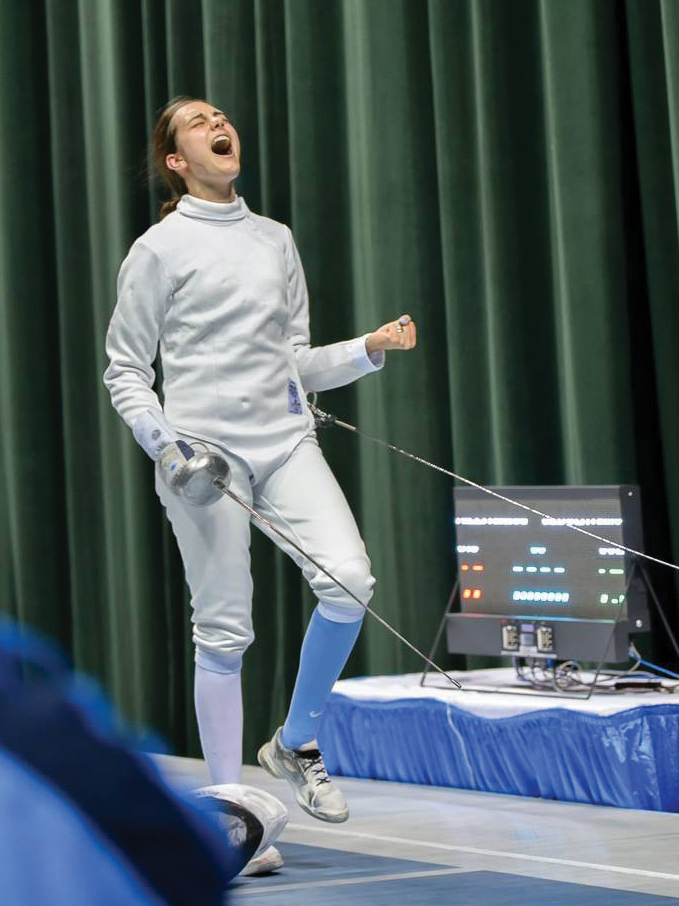
“I’m honored to be a part of history,” the Brooklyn native and neuroscience major says of her March 24, 2019, win for the Columbia Lions’ Fencing team (epee squad), “but I’m more excited at the thought of the future — not just my own, but of what will grow out of the unique relationship that defines the Columbia-Barnard Athletic Consortium.” Barnard is the only women’s college — and one of only a few liberal arts colleges in the country — to offer NCAA Division I athletics, an elite level of competition made possible through the Consortium. Established in 1983, this unique agreement created the opportunity for Barnard students to compete alongside Columbia’s in NCAA Division I and the Ivy League.
Cebula made history in a long line of Barnard student-athletes that stretches back to 1896, seven years after the College was founded, when students created a bicycle club. Intercollegiate competition began in 1902, but was replaced by intramural sports (internal competition) in 1926. In addition to track and field, archery, volleyball, and tennikoit (a tennis-like game played with a rubber ring instead of a ball), intramurals included week-long Greek Games featuring a wide range of activities, from poetry and dance to chariot racing (with students playing the part of horses).
It wasn’t until the 1970s that intercollegiate competition resurfaced, thanks to the passage of Title IX and its prohibition of sex discrimination in any educational program or activity receiving federal financial aid. A surge of interest in sports followed, with ongoing negotiations between Columbia and Barnard over merging, and Barnard students voting to appropriate $10,000 of their student activity fees to sponsor three intercollegiate teams: swimming, basketball, and volleyball. These teams — known collectively as the Barnard Bears — and others that followed between 1975 and 1983 were hampered by a lack of funding. (The basketball and volleyball teams even shared uniforms.) But the determination and passion of the Barnard Bears made them a natural springboard from which to begin Columbia’s women’s program after Columbia College went co-ed in 1983. That year, under the leadership of President Ellen Futter, the two schools signed an agreement for Barnard students to play on Columbia’s Division I teams, and athletic equity was reached.
The struggle to compete — and to even have the right to do so — and succeed requires bravery, teamwork, sacrifice, and commitment. We celebrate the many student-athletes who have performed under these blue banners with a look at five whose contributions both on and off the field help define what being an athlete at Barnard means, while inspiring the next generation of competitors ready to make history.
Trudi Patrick
 The highlight reel of Trudi Patrick ’17’s college swimming career begins with her first year on the Columbia team, when she broke the school record in the 200-meter butterfly and was part of the first team in swimming program history to go undefeated in the dual meet season. (In dual meets, two schools compete.) She was one of a select group to attend the Ivy League swimming championships each of her four years on the team, competed at the 2014 Commonwealth Games and the 2015 Pan Am Games, and served as team captain during her senior year. “It was really a great time in my life,” she says.
The highlight reel of Trudi Patrick ’17’s college swimming career begins with her first year on the Columbia team, when she broke the school record in the 200-meter butterfly and was part of the first team in swimming program history to go undefeated in the dual meet season. (In dual meets, two schools compete.) She was one of a select group to attend the Ivy League swimming championships each of her four years on the team, competed at the 2014 Commonwealth Games and the 2015 Pan Am Games, and served as team captain during her senior year. “It was really a great time in my life,” she says.
Her personal highlights include sharing meals with fellow exhausted swimmers, when they discussed details of the latest practice, older students shared academic advice, and everyone consumed enormous quantities of food. Patrick recalls with a mix of glee and embarrassment how she would take a dish from each of the multiple food stations at Hewitt “and just sit down and go at it.”
The classroom offered her sustenance of a different sort: “Barnard opened my eyes and pushed me to think critically about the society in which we live.” Through the Athena Scholars Program in her senior year, Patrick launched City Kids Swim, a social impact initiative designed to bring swimming to underserved communities. Patrick ran a swim clinic for children ages 4 through 15, which drew an overwhelmingly positive response from parents and children; Patrick continues to provide lessons one-on-one.
Today, she works at Adobe as an account manager and has been working with the Columbia-Barnard Athletic Consortium to plan a women-in-sports event aimed at helping women student-athletes at Columbia and Barnard pivot from school to the working world. She still swims — though only in the summer, at the beach with family or friends. Her three-hour pool practices have been replaced by Zumba.
Juliet Macur
 An award-winning journalist currently working as a “Sports of the Times” columnist at The New York Times, Juliet Macur ’92 is the author of an acclaimed book on Lance Armstrong and recently made news by exposing the exploitation and harassment of NFL cheerleaders. In pursuit of stories that often bring together politics, culture, and athletics, she has traveled the world and flourished in a sphere where, as she puts it, “Some old-school people still feel women shouldn’t be covering sports.”
An award-winning journalist currently working as a “Sports of the Times” columnist at The New York Times, Juliet Macur ’92 is the author of an acclaimed book on Lance Armstrong and recently made news by exposing the exploitation and harassment of NFL cheerleaders. In pursuit of stories that often bring together politics, culture, and athletics, she has traveled the world and flourished in a sphere where, as she puts it, “Some old-school people still feel women shouldn’t be covering sports.”
After graduation, when Macur worked at her first newspaper job, covering the Jacksonville Jaguars for The Orlando Sentinel, a male reporter shouted at her from across a crowded press room, “What do you know about football? You’ve never played the game!”
At that moment and others like it, the grueling experience of rowing crew, which she took up as a sophomore and continued until the birth of her first child in 2010, stood her in good stead. “Because I learned this high degree of toughness from rowing, there has never been an assignment that’s been too hard,” she says. Known for the extreme demands it makes on the entire body, rowing is, as Macur puts it, “pretty much torture” on the best of days. But she recalls with fondness the camaraderie she shared with her teammates and the many early mornings she ran across the darkened campus, dodging startled rats en route to picking up the van she used, as team captain, to drive her teammates to the boathouse.

One practice in particular stands out in her memory: On a very cold morning in the fall, the coach kept the team on the river during a driving rainstorm. The women in the eight-oared boat were exhausted and soaking wet, their hands numb. Yet the practice kept going, the boat racing back and forth between the Henry Hudson Bridge and the Broadway Bridge, at the northern tip of Manhattan, again and again. Macur recalls, “I remember thinking if I could do that and not die, I could probably do anything.” And, indeed, she has.
Philippa Portnoy
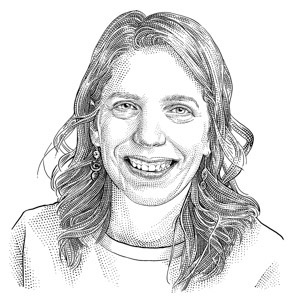 Like a handful of other Barnard alumnae, Manhattan native Philippa Feldman Portnoy ’86, ’90BUS, experienced the transition from Bear to Lion firsthand. She began her first year at the College as a Division III athlete on the tennis team. By graduation, she’d made the switch to Division I, all while staying put on the west side of Broadway. When she arrived on campus in 1982, Columbia hadn’t yet gone co-ed, and the Consortium hadn’t yet been founded, so she began her undergraduate tennis journey as a Barnard Bear, competing exclusively against other Seven Sisters athletes. In Portnoy’s senior year, the team was playing a full Ivy League schedule. When the team first began Ivy League play in 1984, they were beaten badly by Cornell; their triumph against them in 1986 was proof positive of the team’s transformation. “We knew we had come a long way,” Portnoy says.
Like a handful of other Barnard alumnae, Manhattan native Philippa Feldman Portnoy ’86, ’90BUS, experienced the transition from Bear to Lion firsthand. She began her first year at the College as a Division III athlete on the tennis team. By graduation, she’d made the switch to Division I, all while staying put on the west side of Broadway. When she arrived on campus in 1982, Columbia hadn’t yet gone co-ed, and the Consortium hadn’t yet been founded, so she began her undergraduate tennis journey as a Barnard Bear, competing exclusively against other Seven Sisters athletes. In Portnoy’s senior year, the team was playing a full Ivy League schedule. When the team first began Ivy League play in 1984, they were beaten badly by Cornell; their triumph against them in 1986 was proof positive of the team’s transformation. “We knew we had come a long way,” Portnoy says.
Being a member of the tennis team was “the most important part of my experience as an undergrad,” says Portnoy. During early-morning van rides to a practice facility in Fort Lee, New Jersey, she and her teammates shared details of their academic and personal lives, building friendships that continue today. Portnoy learned the power of hard work and dedication and, as team captain, leadership skills she later deployed as head of the Latin American Aviation Finance Group at Citigroup. “At Citigroup, I worked in a fairly male-dominated industry, traveling the world, and I wasn’t intimidated by any of that.”
Today, Portnoy is a member of Barnard’s Board of Trustees and remains deeply invested in supporting the institution that helped shape her. A founding member of the Athena Center for Leadership, she’s also a co-founder of the Women’s Leadership Council for Athletics, which has raised approximately $4 million for athletics over the past 10 years. Though she says she’s focused on raising her 17-year-old triplets, Portnoy is as busy as any athlete in training season. She is a member of Columbia’s Alumnae Engagement Committee and helped to plan the first University-wide women’s conference, held last year. Portnoy also serves on numerous Columbia and Barnard committees, was a 2014 Columbia Alumni Association medalist, and was named one of the 25 most influential athletes of the Columbia- Barnard Athletics Consortium. “Being on the team, and being team captain, gave me confidence in my voice.”
I remember thinking if I could do that and not die, I could probably do anything.

Robin Wagner
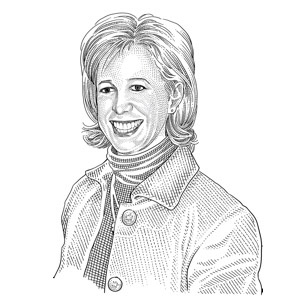 In 1976, Robin Wagner ’80 embarked on a schedule of training and academics at Barnard that only a nationally ranked 19-year-old figure skater could have mapped out. To maintain her relationship with her longtime coach and enjoy the support of her family, she lived at home on Long Island, where six days a week she rose at 4 a.m. and practiced for four hours. Weekdays, she then took the train to Barnard where she maintained a full course load, and next headed to ballet lessons or to a rink in the city for additional practice before commuting home. In high school, such a balancing act had worked. But Barnard presented new challenges, and both her schoolwork and skating suffered. Determined to test herself as an athlete, she took a semester off, setting her sights on competing at senior nationals, where U.S. champions are crowned. But the goal eluded her, and with a heavy heart, she said goodbye to the sport that had defined her life for years.
In 1976, Robin Wagner ’80 embarked on a schedule of training and academics at Barnard that only a nationally ranked 19-year-old figure skater could have mapped out. To maintain her relationship with her longtime coach and enjoy the support of her family, she lived at home on Long Island, where six days a week she rose at 4 a.m. and practiced for four hours. Weekdays, she then took the train to Barnard where she maintained a full course load, and next headed to ballet lessons or to a rink in the city for additional practice before commuting home. In high school, such a balancing act had worked. But Barnard presented new challenges, and both her schoolwork and skating suffered. Determined to test herself as an athlete, she took a semester off, setting her sights on competing at senior nationals, where U.S. champions are crowned. But the goal eluded her, and with a heavy heart, she said goodbye to the sport that had defined her life for years.
Wagner re-enrolled at Barnard and found in her classmates a level of intellectual curiosity that inspired her and shaped the coach she would later become. “There was a culture of not being satisfied with traditional answers,” she says. When she began coaching a young skater, that experience “kept me going, kept me asking questions, and allowed me the confidence in myself and my skater when other people had doubts.” The young skater Wagner coached, Sarah Hughes, won the gold medal for the U.S. at the 2002 Olympics in Salt Lake City. Wagner went on to coach two more women who competed in the Olympics. Now she is “a retired old woman enjoying life” in Palm Beach Gardens, Florida, where her biggest athletic challenge is learning to play golf. “After having spent so many years in a refrigerator as a competitor and a coach,” she says, “I’m ready for some warm weather.”
four hours. Weekdays, she then took the train to Barnard where she maintained a full course load, and next headed to ballet lessons or to a rink in the city for additional practice before commuting home. In high school, such a balancing act had worked. But Barnard presented new challenges, and both her schoolwork and skating suffered. Determined to test herself as an athlete, she took a semester off, setting her sights on competing at senior nationals, where U.S. champions are crowned. But the goal eluded her, and with a heavy heart, she said goodbye to the sport that had defined her life for years.
Wagner re-enrolled at Barnard and found in her classmates a level of intellectual curiosity that inspired her and shaped the coach she would later become. “There was a culture of not being satisfied with traditional answers,” she says. When she began coaching a young skater, that experience “kept me going, kept me asking questions, and allowed me the confidence in myself and my skater when other people had doubts.” The young skater Wagner coached, Sarah Hughes, won the gold medal for the U.S. at the 2002 Olympics in Salt Lake City. Wagner went on to coach two more women who competed in the Olympics. Now she is “a retired old woman enjoying life” in Palm Beach Gardens, Florida, where her biggest athletic challenge is learning to play golf. “After having spent so many years in a refrigerator as a competitor and a coach,” she says, “I’m ready for some warm weather.”
Gloria Callen Jones
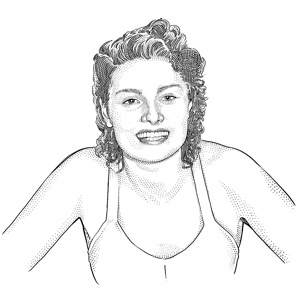 When Gloria Callen entered Barnard as a first-year in 1942, she had already set 35 American swimming records and one world record, won 13 national titles, and been voted Female Athlete of the Year by the Associated Press. She also had been selected for the Olympic team that would have represented the United States at the 1940 games but were canceled due to the outbreak of World War II. In addition to her athletic feats, “Glorious Gloria” was celebrated for her looks and glamour: Featured on the cover of Cosmopolitan magazine and profiled in Life, she was voted one of the country’s best-dressed women. But when she arrived at Barnard, she did not join the swim team — there wasn’t one to join — and she never competed in swimming again.
When Gloria Callen entered Barnard as a first-year in 1942, she had already set 35 American swimming records and one world record, won 13 national titles, and been voted Female Athlete of the Year by the Associated Press. She also had been selected for the Olympic team that would have represented the United States at the 1940 games but were canceled due to the outbreak of World War II. In addition to her athletic feats, “Glorious Gloria” was celebrated for her looks and glamour: Featured on the cover of Cosmopolitan magazine and profiled in Life, she was voted one of the country’s best-dressed women. But when she arrived at Barnard, she did not join the swim team — there wasn’t one to join — and she never competed in swimming again.
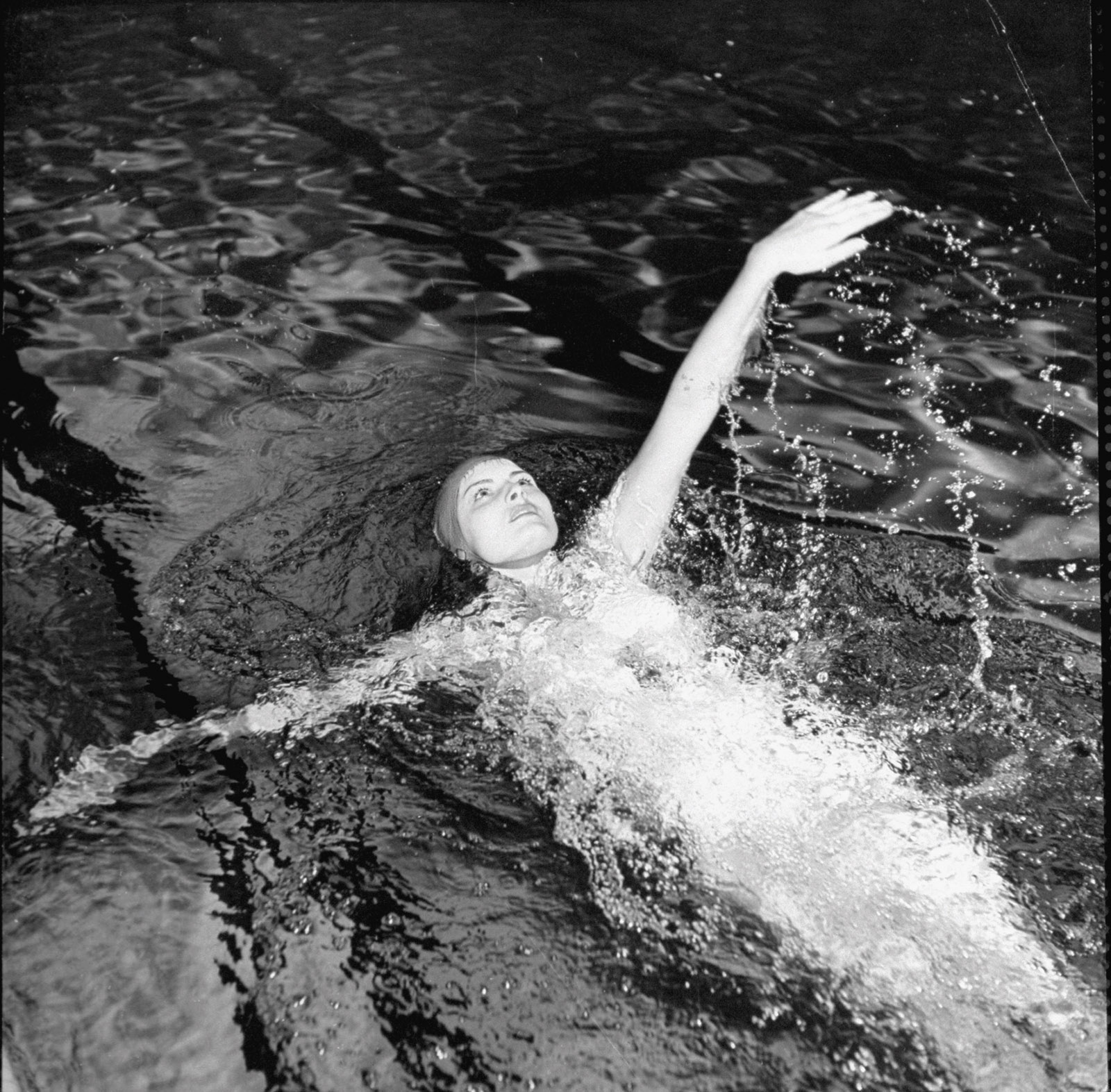
Instead, she participated in aquatic novelty events, including one called “Aqua-Ducks.” Performed with classmate Anne Ross ’45, a nationally ranked diver who was also selected for the 1940 U.S. Olympic team, Aqua-Ducks featured water ballet, tandem swimming, and a nightshirt race. Described by her eldest daughter, Christine Huber, as “very vivacious, fun-loving and effervescent,” Callen, who died in 2016, was also active in dance committees. At a dance in 1943, she met Herbert Jones, Jr., a young midshipman training on a Navy Reserves ship docked in the Hudson who had, along with other midshipmen, been ordered to attend. A year later, the two were married in St. Paul’s Chapel at Columbia. Huber says Jones “really loved college,” but once her husband returned to the U.S. after serving in the Pacific, there “wasn’t a thought” that they would stay apart; Jones left Barnard to join him in San Francisco.
Callen was a strong believer in women’s rights who encouraged all three of her daughters to become feminists. She lived for many years in Charleston, West Virginia, where she was an active volunteer in many local organizations, held multiple leadership positions at the Garden Club of America, and was a member of Barnard’s Board of Trustees from 1986 to 1991. Callen maintained many strong friendships from her college days, says Huber. “She took great pride in having gone to Barnard.” •
